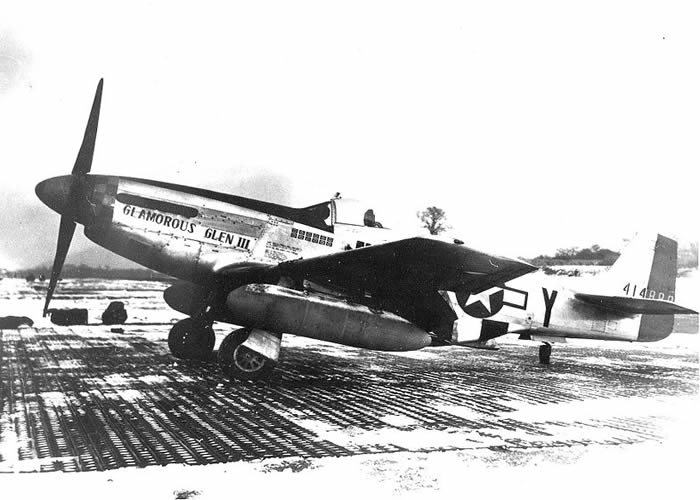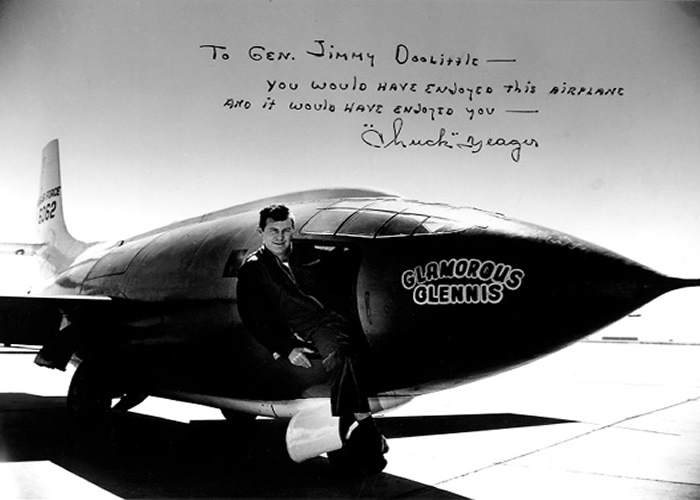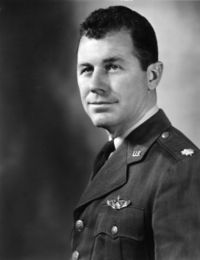Yeager broke the sound barrier on October 14, 1947,
flying the experimental Bell X-1 at Mach 1 at
an altitude of 45,000 feet (13,700 m)
Yeager was born to farming-parents Susie Mae and Albert Hal Yeager in Myra, West Virginia and graduated from high school in Hamlin, West Virginia. Yeager had two brothers, Roy and Hal, Jr., and two sisters, Doris Ann (accidentally killed by Roy with a shotgun while still an infant) and Pansy Lee. His first association with the military was as a participant in the Citizens Military Training Camp at Fort Benjamin Harrison, Indianapolis, Indiana, during both the summers of 1939 and 1940. On February 26, 1945, Yeager married Glennis Dickhouse, and the couple had four children. Glennis Yeager died in 1990.
Chuck Yeager is not related to Jeana Yeager, one of the two pilots of the Rutan Voyager aircraft, which circled the world without landing or refueling. The name "Yeager" is an Anglicized form of the German, Dutch and Scandinavian name, Jäger (German: "hunter") , and so is common among immigrants of those communities. He is the uncle of former baseball catcher Steve Yeager.
World War II
Yeager enlisted as a private in the U.S. Army Air Forces (USAAF) on September 12, 1941, and became an aircraft mechanic at George Air Force Base, Victorville, California. When he enlisted Yeager was not eligible for flight training because of his age and educational background, but the entry of the U.S. into World War II less than two months later prompted the USAAF to alter its recruiting standards. Blessed with remarkable 20/10 vision, Yeager displayed natural talent as a pilot and was accepted for flight training. He received his wings and a promotion to Flight Officer at Luke Field, Arizona, where he graduated from class 43C on March 10, 1943. Assigned to the 357th Fighter Group at Tonopah, Nevada, he initially trained as a fighter pilot flying P-39 Airacobras and went overseas with the group on November 23, 1943.

Stationed in the United Kingdom at RAF Leiston, Yeager flew P-51 Mustangs in combat (he named his aircraft Glamorous Glennis after his girlfriend, Glennis Faye Dickhouse, who became his wife in February 1945) with the 363rd Fighter Squadron. He had gained one victory before he was shot down over France on his eighth mission, on March 5, 1944. He escaped to Spain on March 30 with the help of the Maquis (French Resistance) and returned to England on May 15, 1944. During his stay with the Maquis, Yeager assisted the guerrillas in duties that did not involve direct combat, though he did help to construct bombs for the group, a skill that he had learned from his father. He was awarded the Bronze Star for helping another airman, who lost part of his leg during the escape attempt, to cross the Pyrenees.
Despite a regulation that "evaders" (escaped pilots) could not fly over enemy territory again to avoid compromising Resistance allies, Yeager was reinstated to flying combat. Yeager had joined a bomber pilot evader, Capt. Fred Glover, in speaking directly to the Allied Supreme Commander, General Dwight D. Eisenhower, on June 12, 1944. With Glover pleading their case, arguing that because the Allies had invaded France, the Maquis resistance movement was by then openly fighting the Nazis alongside Allied troops, so there was little or nothing they could reveal if shot down again to expose those who had helped them evade capture. Eisenhower, after gaining permission from the War Department to decide the requests, concurred with Yeager and Glover. Yeager later credited his postwar success in the Air Force to this decision, saying that his test pilot career followed naturally from being a decorated combat ace with a good kill record, along with being an airplane maintenance man prior to attending pilot school. In part because of his maintenance background, Yeager also frequently served as a maintenance officer in his flying units.
Yeager possessed outstanding eyesight (rated as 20/10, once enabling him to shoot a deer at 600 yards (550 m), flying skills, and combat leadership; he distinguished himself by becoming the first pilot in his group to make "ace in a day": he shot down five enemy aircraft in one mission, finishing the war with 11.5 official victories, including one of the first air-to-air victories over a jet fighter (a German Messerschmitt Me 262). Two of his "ace in a day" kills were scored without firing a single shot; he flew into firing position against a Messerschmitt Bf 109 and the pilot of the aircraft panicked, breaking to starboard and colliding with his wingman; Yeager later reported both pilots bailed out. An additional victory that was not officially counted for him came during the period before his combat status was reinstated: during a training flight in his P-51 over the North Sea, he happened on a German Junkers Ju 88 heavy fighter attacking a downed B-17 Flying Fortress crew. Yeager's quick thinking and reflexes saved the B-17 crew, but because he was not yet cleared for flying combat again, his gun camera film and credit for the kill were given to his wingman, Eddie Simpson. (Yeager later mistakenly recalled that the credit had given Simpson his fifth kill).
Yeager was commissioned a second lieutenant while at Leiston and was promoted to captain before the end of his tour. He flew his sixty-first and final mission on January 15, 1945, and returned to the United States in early February. As an evader, he received his choice of assignments and because his new wife was pregnant, chose Wright Field to be near his home in West Virginia. His high flight hours and maintenance experience qualified him to become a functional test pilot of repaired aircraft, which brought him under the command of Colonel Albert Boyd, head of the Aeronautical Systems Flight Test Division.
Post-War
Yeager remained in the Air Force after the war, becoming a test pilot at Muroc Army Air Field (now Edwards Air Force Base) and eventually being selected to fly the rocket-powered Bell X-1 in a NACA program to research high-speed flight, after Bell Aircraft test pilot "Slick" Goodlin demanded $150,000 to break the sound "barrier." Such was the difficulty in this task that the answer to many of the inherent challenges were along the lines of "Yeager better have paid-up insurance." Yeager broke the sound barrier on October 14, 1947, flying the experimental X-1 at Mach 1 at an altitude of 45,000 feet (13,700 m). Two nights before the scheduled date for the flight, he broke two ribs while riding a horse. He was so afraid of being removed from the mission that he went to a veterinarian in a nearby town for treatment and told only his wife, as well as friend and fellow project pilot Jack Ridley about it.

On the day of the flight, Yeager was in such pain that he could not seal the airplane's hatch by himself. Ridley rigged up a device, using the end of a broom handle as an extra lever, to allow Yeager to seal the hatch of the airplane. Yeager's flight recorded Mach 1.07, however, he was quick to point out that the public paid attention to whole numbers and that the next milestone would be exceeding Mach 2. Yeager's X-1 is on display at the Smithsonian Institution's National Air and Space Museum. Yeager was awarded the MacKay and Collier Trophies in 1948 for his mach-transcending flight, and the Harmon International Trophy in 1954.
Some aviation historians contend that American pilot George Welch broke the sound barrier before Yeager, once while diving an XP-86 Sabre on October 1, 1947, and again just 30 minutes before Yeager's X-1 flight. There was also a disputed claim by German pilot Hans Guido Mutke that he was the first person to break the sound barrier, on April 9, 1945, in a Messerschmitt Me 262.
Yeager went on to break many other speed and altitude records. He also was one of the first American pilots to fly a MiG-15 after its pilot defected to South Korea with it. During the latter half of 1953, Yeager was involved with the USAF team that was working on the X-1A, an aircraft designed to surpass Mach 2 in level flight. That year, he flew a chase plane for the female civilian pilot Jackie Cochran, a close friend, as she became the first woman to fly faster than sound. However, on November 20, 1953, the NACA's D-558-II Skyrocket and its pilot, Scott Crossfield, became the first team to reach twice the speed of sound. After they were bested, Ridley and Yeager decided to beat rival Crossfield's speed record in a flight series that they dubbed "Operation NACA Weep." Not only did they beat Crossfield, but they did it in time to spoil a celebration planned for the 50th anniversary of flight in which Crossfield was to be called "the fastest man alive." The Ridley/Yeager USAF team achieved Mach 2.44 on December 12, 1953. Shortly after reaching Mach 2.44, he experienced a loss of aerodynamic control due to inertial coupling at approximately 80,000 ft (24,000 m)., Yeager lost control of the X-1A. With the aircraft out of control, simultaneously rolling, pitching and yawing out of the sky, Yeager dropped 51,000 feet (16,000 m) in 51 seconds until regaining control of the aircraft at approximately 29,000 feet (8,800 m). He was able to land the aircraft without further incident.

Yeager was foremost a fighter pilot and held several squadron and wing commands. From May 1955 to July 1957 he commanded the F-86H Sabre-equipped 417th Fighter-Bomber Squadron (50th Fighter-Bomber Wing) at Hahn AB, Germany, and Toul-Rosieres Air Base, France; and from 1957 to 1960 the F-100D-equipped 1st Fighter Day Squadron (later, while still under Yeager's command, re-designated the 306th Tactical Fighter Squadron) at George Air Force Base, California, and Morón Air Base, Spain.
In 1962, after completion of a year's studies at the Air War College, he was the first commandant of the USAF Aerospace Research Pilot School, which produced astronauts for NASA and the USAF, after its redesignation from the USAF Flight Test Pilot School. An accident during a test flight in one of the school's NF-104s put an end to his record attempts. Between December 1963 and January 1964, Yeager completed five flights in the NASA M2-F1 lifting body.
In 1966 he took command of the 405th Tactical Fighter Wing at Clark Air Base, the Philippines, whose squadrons were deployed on rotational temporary duty (TDY) in South Vietnam and elsewhere in Southeast Asia. There he accrued another 414 hours of combat time in 127 missions, mostly in a Martin B-57 light bomber. In February 1968, he was assigned command of the 4th Tactical Fighter Wing at Seymour Johnson Air Force Base, North Carolina, and led the F-4 Phantom wing in South Korea during the Pueblo crisis.
On June 22, 1969, he was promoted to brigadier general, and was assigned in July as the vice-commander of the Seventeenth Air Force. In 1971, Yeager was assigned to Pakistan to advise the Pakistan Air Force at the behest of then-Ambassador Joe Farland. Prior to the start of hostilities of the Bangladesh War he is reported to have said that the Pakistani army would be in New Delhi within a week. During the war, his twin-engined Beechcraft was destroyed in an Indian air raid on the Chaklala air base - he was reportedly incensed and demanded US retaliation. Despite Pakistan's surrender to India in the Indo-Pakistani War of 1971, Yeager stayed in Pakistan until March 1973, and recalled his stay in Pakistan as one of the most enjoyable times of his life. During his stay he spent most of his time flying in an F-86 Sabre with the Pakistan Air Force and making several expeditions to the K2 mountain, vacationing in Swat, Pakistan, trekking and hunting in the Northern Areas and learning the Urdu language. |








